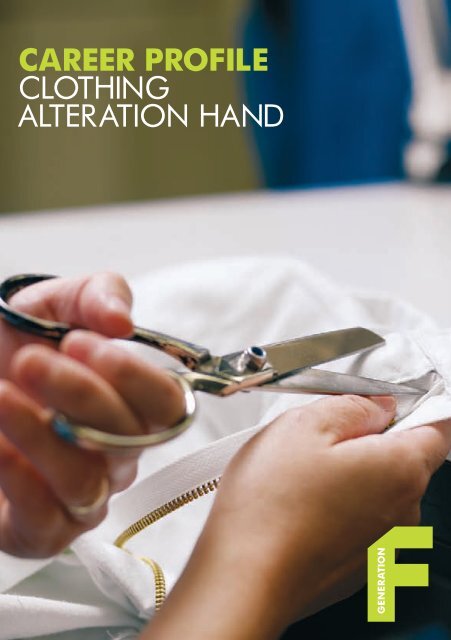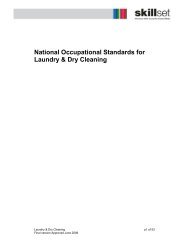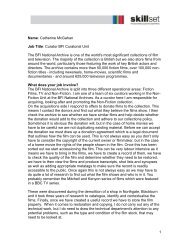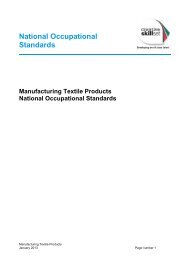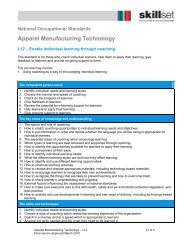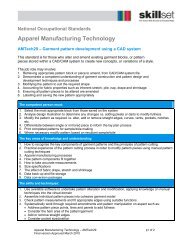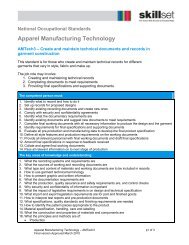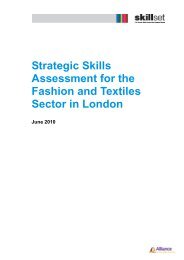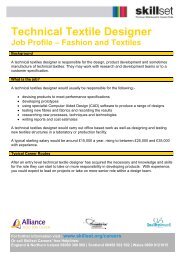CAREER PROFILE CLOTHING ALTERATION HAND - Skillset
CAREER PROFILE CLOTHING ALTERATION HAND - Skillset
CAREER PROFILE CLOTHING ALTERATION HAND - Skillset
You also want an ePaper? Increase the reach of your titles
YUMPU automatically turns print PDFs into web optimized ePapers that Google loves.
<strong>CAREER</strong> <strong>PROFILE</strong><br />
Clothing<br />
Alteration Hand
Clothing alteration hands<br />
modify and repair items<br />
of clothing. They may use<br />
hand or machine sewing<br />
techniques and will have<br />
expert knowledge of<br />
garment construction.<br />
What does a clothing<br />
alteration hand do<br />
They may be involved in fastening<br />
new zips, taking in or letting out<br />
seams, shortening or lengthening<br />
hems and replacing trims. Clothing<br />
alteration hands may also work<br />
on specialist pieces, such as<br />
bridal gowns.<br />
The salary of a clothing<br />
alteration hand<br />
When starting out, a clothing<br />
alteration hand could expect to be<br />
paid around £11,000 a year with<br />
experience earning up to £16,000.<br />
Supervisors could earn £22,000<br />
a year or more.<br />
Hours and working environment<br />
Alteration hands usually work around<br />
40 hours a week. Saturday work<br />
is common for those employed in<br />
laundries and dry-cleaners.<br />
Part-time work and flexible hours<br />
are very common.<br />
A self-employed alteration hand<br />
may have a small, home-based<br />
workroom. Those based in a laundry<br />
or dry-cleaners may have a small<br />
workroom or working area within<br />
the store. Workrooms are usually<br />
warm and well-lit but can be small<br />
and cramped.<br />
Skills and interests<br />
To have a career as a clothing<br />
alteration hand, it is important to<br />
have good sewing skills. These can<br />
be obtained on a relevant course but<br />
on-the-job experience is also very<br />
valuable. The following skills and<br />
interests would also be useful:<br />
* an interest in fashion and a<br />
knowledge of tends and fabrics<br />
*<br />
*<br />
a focused approach to work with<br />
attention to detail<br />
to be self-motivated and able to<br />
work alone and to deadlines<br />
Entry into a career in<br />
clothing alteration<br />
Work-based learning qualifications<br />
such as apprenticeships or NVQs are<br />
a common way to get started as a<br />
clothing alteration hand and many<br />
companies will prefer candidates<br />
to have a relevant qualification.<br />
Check what options are available<br />
at your local college or visit<br />
www.abcawards.co.uk<br />
Further training to develop a<br />
career in clothing alteration<br />
Mastering different sewing<br />
techniques comes with experience.<br />
It can be useful to work alongside<br />
more experienced alteration hands<br />
to enhance practical knowledge.<br />
A wide range of short courses,<br />
qualifications and workshops in<br />
tailoring and garment production<br />
are also available from the<br />
London College of Fashion<br />
www.fashion.arts.ac.uk.<br />
Opportunities in the field of<br />
clothing alteration<br />
Opportunities for promotion may be<br />
limited, although supervisory posts<br />
may be available in larger companies<br />
to those with the relevant experience.<br />
Experienced alteration hands could<br />
become self-employed and may<br />
combine alteration work with design<br />
and craft roles. Strong business<br />
and marketing skills are useful for<br />
those who become self-employed.<br />
Experienced clothing alteration<br />
hands may also move into teaching.<br />
Case study<br />
Gail Sharlotte has<br />
worked at Johnson<br />
Apparelmaster for 20<br />
years as a clothing<br />
alteration hand and<br />
has always had a<br />
passion for sewing.<br />
When Gail started work,<br />
no formal qualifications<br />
were available in sewing<br />
so learned most of her<br />
skills on-the-job or at<br />
school. Gail says “Don’t be<br />
afraid to ask for help there<br />
will always be someone<br />
around to offer you tips<br />
and advice. You need to<br />
have a good eye for detail,<br />
have an understanding<br />
of garment construction<br />
and be conscientious as<br />
someone will have to wear<br />
the garment you are<br />
working on”.<br />
Gail’s work is varied as she<br />
may be repairing an arm<br />
sleeve one minute and<br />
attaching a new collar<br />
the next. Gail says “I love<br />
the work I do as it’s really<br />
varied and interesting<br />
with every garment<br />
requiring something<br />
different and I really look<br />
forward to coming to work.”<br />
For more information visit<br />
www.skillfast-uk.org/generationf
<strong>CAREER</strong> <strong>PROFILE</strong><br />
Garment<br />
Technologist
Garment technologists<br />
support the design and<br />
buying team through all<br />
stages of garment product<br />
development, from<br />
design to manufacture.<br />
Garment technologists<br />
can be employed by<br />
manufacturers or large,<br />
high-street retailers.<br />
What does a garment<br />
technologist do<br />
The garment technologist would be<br />
involved in choosing an appropriate<br />
fabric and design, which will be<br />
in budget. They would then work<br />
with the pattern graders to oversee<br />
the sizing, fitting and testing of the<br />
pre-production garments. A garment<br />
technologist would also analyse<br />
product returns and faults.<br />
The salary of a<br />
garment technologist<br />
A garment technologist may be paid<br />
between £15,000 and £18,000 a<br />
year when starting out. This could<br />
increase to around £25,000 a year<br />
with experience. Senior garment<br />
technologists can earn around<br />
£50,000 a year.<br />
Hours and working environment<br />
A garment technologist would<br />
typically work around 38 hours<br />
a week, this can increase during<br />
busy times and when deadlines<br />
have to be met.<br />
For the majority of the time, a<br />
garment technologist is office-based<br />
and the job can involve working<br />
in a design studio. A garment<br />
technologist may be required to<br />
travel for work, both within the<br />
UK and overseas.<br />
Skills and interests<br />
It may be useful for someone<br />
considering a career in garment<br />
technology to have some of the<br />
following skills and interests:<br />
* an understanding of manufacturing<br />
processes and textile properties<br />
*<br />
*<br />
the ability to work well alone<br />
or as part of a team<br />
the ability to work under pressure<br />
and to tight deadlines<br />
For more information visit<br />
www.skillfast-uk.org/generationf<br />
Entry into a career in<br />
garment technology<br />
A relevant degree is usually preferred<br />
on entry to this industry. Relevant<br />
degrees are available in clothing<br />
technology and production from<br />
a number of universities, visit the<br />
UCAS website: www.ucas.com<br />
for more information.<br />
Work experience is also a good<br />
way of gaining experience of the<br />
industry and making contacts.<br />
Further training to develop a<br />
career in garment technology<br />
On-the-job development of practical<br />
knowledge and skills is critical<br />
to this role. Experience and skills<br />
development will lead to promotion<br />
opportunities.<br />
Short and part-time courses are<br />
also available which may be suitable<br />
for those already working in the<br />
industry. Other qualifications<br />
are available from ABC awards,<br />
visit www.abcawards.co.uk<br />
The Textile Institute also covers<br />
the apparel industry and offers<br />
a range of qualifications, for<br />
more information see the website:<br />
www.texi.org<br />
Opportunities in the field<br />
of garment technology<br />
Graduates will usually join a<br />
company in a junior role, working<br />
their way up through the areas<br />
of product development, quality<br />
control or buying before becoming<br />
a garment technologist.<br />
With experience, it may be possible<br />
to gain promotion into more senior<br />
positions, such as senior technologist<br />
or technical manager. It may also<br />
be possible for a senior garment<br />
technologist to progress into a role<br />
in research within a university or<br />
similar institution.<br />
Case study<br />
Peter Capewell has<br />
worked for Simon Jersey,<br />
a leading corporate<br />
and workwear specialist<br />
based near Accrington,<br />
for two years as a<br />
garment technologist.<br />
Peter started his career as<br />
a pattern cutter working<br />
for numerous companies<br />
including a bespoke tailor<br />
and a mail order company.<br />
He has taken a variety of<br />
qualifications to develop<br />
his skills and gain a better<br />
understanding of fabrics<br />
and garment construction.<br />
Peter had some great<br />
mentors over the years<br />
that encouraged his<br />
development and provided<br />
him with experience to move<br />
into garment technology.<br />
Peter says “Having worked<br />
extensively with a variety<br />
of products means I have<br />
a great deal of knowledge<br />
and understanding of<br />
garment construction which<br />
is essential for my job.”<br />
Team working with the<br />
textile technologist and<br />
pattern cutter ensures the<br />
best product is made for<br />
the customer and allows<br />
maximum creativity.<br />
Peter’s job has allowed<br />
for extensive travel as<br />
many fabrics and finished<br />
garments are made now<br />
overseas. Peter says “Good<br />
all round knowledge of<br />
clothing and fabrics makes<br />
my job easier especially<br />
when working with overseas<br />
companies but seeing a new<br />
product developed from<br />
start to finish is fantastic.”
<strong>CAREER</strong> <strong>PROFILE</strong><br />
Laundry<br />
Maintenance<br />
Engineer
A laundry maintenance<br />
engineer is responsible for<br />
ensuring machinery and<br />
equipment at the laundry<br />
plant runs efficiently<br />
and smoothly. They must<br />
have expert knowledge<br />
in mechanical, electrical,<br />
hydraulic, pneumatic and<br />
computerised systems.<br />
What does a laundry<br />
maintenance engineer do<br />
Their work revolves around ensuring<br />
machinery for washing and drying<br />
clothes for a commercial laundry is<br />
working efficiently and effectively.<br />
They are also responsible for testing<br />
the water used by washing machines<br />
to make sure it is balanced correctly<br />
for clothes washing.<br />
Senior engineers and managers will<br />
also be involved with administration<br />
work to ensure systems and<br />
procedures are adhered to.<br />
The salary of a laundry<br />
maintenance engineer<br />
A laundry maintenance engineer<br />
could expect to be paid around<br />
£16,000 per year as an apprentice<br />
engineer, with experience this can<br />
rise to £21,000. Supervisors will<br />
earn around £18,000 to £25,000.<br />
Managers could earn up to £30,000<br />
per year or more.<br />
Hours and working environment<br />
Laundry maintenance engineers<br />
usually work around 39 hours a<br />
week. Although weekend work is<br />
not common in a commercial<br />
laundry, you will be required to<br />
be ‘on-call’ occasionally in case<br />
of emergency breakdowns.<br />
Laundry maintenance engineers<br />
working environment is on the plant<br />
floor and will be working closely<br />
with machinery so it can be noisy.<br />
Due to working with water and<br />
steam it can be hot.<br />
Skills and interests<br />
You will need to be multi-skilled<br />
with electrical and mechanical<br />
qualifications and knowledge.<br />
A good understanding of maths<br />
and science is also essential.<br />
* an interest in machinery<br />
and fixing equipment<br />
*<br />
*<br />
to be logical, practical<br />
and adaptable<br />
to be self-motivated to work<br />
alone or as part of a team<br />
* physically fit<br />
Entry into a career in laundry<br />
maintenance engineering<br />
You will need some qualifications<br />
to become an engineer and passes<br />
in maths and science GCSE are a<br />
must. Work-based apprenticeships<br />
are a common route for many<br />
entering engineering. For more<br />
information on apprenticeships,<br />
visit the apprenticeship website:<br />
www.apprenticeships.org.uk.<br />
The Institution of Engineering and<br />
Technology website has details<br />
of UK colleges offering<br />
engineering courses.<br />
Further training to develop<br />
a career in laundry<br />
maintenance engineering<br />
As technology changes and becomes<br />
more efficient, many engineers find<br />
they need to do short courses to keep<br />
their skills and knowledge up to date.<br />
Many businesses will assist with this<br />
element of further training and it will<br />
often be tailored to suit the business<br />
you work for.<br />
Opportunities in the field of a<br />
laundry maintenance engineer<br />
Once you have an engineering<br />
qualification you can move into<br />
many sectors not just laundry and<br />
dry cleaning. There are opportunities<br />
to develop your skills and training<br />
and you can work your way up to<br />
supervisor or managerial levels in<br />
some companies.<br />
Case study<br />
Andy Pitts has worked at<br />
Johnson Apparelmaster<br />
for almost two years<br />
and has recently been<br />
promoted to senior<br />
maintenance engineer at<br />
the commercial laundry<br />
based in Hull.<br />
Andy worked while studying<br />
for his marine engineering<br />
apprenticeship. This led him<br />
to do engineering work in<br />
many areas including boiler<br />
maintenance and laundry.<br />
Andy says “To become a<br />
maintenance engineer you<br />
need to be multi-skilled with<br />
electrical and mechanical<br />
training. You need to be<br />
able to think problems<br />
through logically and have<br />
a good head for numbers.<br />
Being physically fit is also<br />
an advantage.”<br />
Andy’s job is not just about<br />
working with hand tools,<br />
many of the machines are<br />
computerised so expertise<br />
in electronics and electrics<br />
are essential. There is also<br />
a very scientific element<br />
involved to make the water<br />
soft for washing clothes.<br />
Andy says “My work is<br />
really varied as every<br />
problem is different so<br />
it makes it interesting.<br />
Technology is always<br />
changing so I am always<br />
learning something new.”<br />
For more information visit<br />
www.skillfast-uk.org/generationf
<strong>CAREER</strong> <strong>PROFILE</strong><br />
Pattern Cutter<br />
or Grader
A pattern cutter is<br />
responsible for turning<br />
a designer’s sketch into<br />
a working pattern,<br />
which can be used when<br />
constructing the garment.<br />
A pattern grader takes<br />
a pattern and produces<br />
scaled-up and scaleddown<br />
versions, to enable<br />
manufacturers to reproduce<br />
the same garment,<br />
but in different sizes.<br />
These roles will often be<br />
combined together.<br />
What does a pattern cutter<br />
or grader do<br />
A pattern cutter takes a designer’s<br />
drawing or modifies existing patterns<br />
to create a prototype pattern<br />
template. A typical technique is to<br />
cut pieces of fabric, which are then<br />
draped and pinned over a dummy<br />
until they hang correctly. Each piece<br />
is then used to create a cut-out card<br />
or paper template.<br />
Using this prototype pattern, pattern<br />
graders produce different pattern<br />
sizes so that clothing manufacturers<br />
can re-create one design in a variety<br />
of different sizes. They alter the<br />
proportions digitally or by hand.<br />
The different pattern grades are<br />
then sent to clothing manufacturers,<br />
enabling them to produce the<br />
finished garments.<br />
The salary of a pattern<br />
cutter or grader<br />
The starting salary of a pattern cutter<br />
or grader can be between £11,000<br />
and £18,000 a year. Experienced<br />
cutters/grader can earn over<br />
£20,000 a year.<br />
Hours and working environment<br />
Pattern cutters and graders normally<br />
work between 37 and 39 hours<br />
a week. Overtime hours may<br />
be required when working to<br />
deadlines and part-time hours<br />
may be available.<br />
They would normally be based in<br />
a studio or workroom; this space<br />
will be light and well lit. It will also<br />
be spacious so that patterns can be<br />
laid out. Those using computerised<br />
programmes may also be based in<br />
front of a computer screen.<br />
Skills and interests<br />
It may be useful for someone<br />
considering a career as a pattern<br />
cutter or grader to have some<br />
of the following skills and interests.<br />
* an interest in fashion and trends<br />
* the ability to interpret a designer’s<br />
working drawing<br />
*<br />
knowledge of garment construction<br />
and pattern cutting techniques<br />
* good IT and numeracy skills<br />
* the ability to work quickly and<br />
accurately within a team<br />
Entry into a career in pattern<br />
cutting or grading<br />
There is a strong demand for pattern<br />
cutters and graders with the relevant<br />
technical skills and so employers<br />
usually look for people who have<br />
some form of relevant training.<br />
The usual route into this work is<br />
to begin as a pattern cutting or<br />
grading assistant. With training<br />
and experience it is possible to<br />
progress into the role of pattern<br />
cutter or grader.<br />
For more information on the ABC<br />
qualifications, visit the website:<br />
www.abcawards.co.uk<br />
Some fashion design degree courses<br />
incorporate the key technical<br />
elements needed for a career in this<br />
area. For more information about<br />
university courses, visit the UCAS<br />
website: www.ucas.co.uk<br />
Further training to develop<br />
a career in pattern cutting<br />
or grading<br />
It may be possible for those working<br />
in the sector to work towards the<br />
following qualifications whilst<br />
on the job.<br />
Several institutions, such as the<br />
London College of Fashion www.<br />
fashion.arts.ac.uk offer short courses<br />
in pattern cutting. The Textile<br />
Institute www.texi.org also offer a<br />
range of professional qualifications.<br />
Opportunities in the field of<br />
pattern cutting or grading<br />
A pattern cutter or grader with the<br />
relevant experience can expect to be<br />
promoted to head pattern cutter or<br />
grader overseeing a team of pattern<br />
cutters/graders. They may also be<br />
able to move into a career in design<br />
or buying.<br />
Case study<br />
Mary Aspinall is a<br />
pattern cutter and grader<br />
for Simon Jersey, a<br />
leading corporate and<br />
workwear specialist<br />
based near Accrington.<br />
Mary has seventeen<br />
years pattern cutting<br />
and grading experience.<br />
Mary completed a fashion<br />
design course which covered<br />
some pattern cutting. Upon<br />
graduating, she decided<br />
that a hands-on role would<br />
suit her best and chose to<br />
become a pattern cutter.<br />
Making clothes into different<br />
sizes, known as grading, is<br />
a skill she has learnt during<br />
her working life and the use<br />
of computers is essential for<br />
this element of the job.<br />
Mary’s has developed an<br />
eye for what is a good fit<br />
and cut, Mary says “My<br />
experience means that<br />
without looking too closely<br />
at a garment I can see<br />
how well it’s been cut. It’s<br />
particularly important that<br />
corporate wear is made<br />
well and comfortable as<br />
it represents a brand, is<br />
sometimes worn for long<br />
periods of time and needs<br />
to last.”<br />
Mary adds “There’s always<br />
a new challenge with my<br />
job, turning a design into<br />
a finished garment that’s<br />
wearable, looks good<br />
and meets the design<br />
expectations is really<br />
rewarding.”<br />
For more information visit<br />
www.skillfast-uk.org/generationf
<strong>CAREER</strong> <strong>PROFILE</strong><br />
Sample Machinist
Sample machinists are<br />
a key part of the clothing<br />
design team. They work<br />
closely with designers,<br />
garment technologists<br />
and pattern cutters<br />
to create the first<br />
made-up sample<br />
of a garment design.<br />
What does a sample<br />
machinist do<br />
A sample machinist will follow the<br />
instructions of the designer, pattern<br />
cutter and garment technologist<br />
when sewing the sample together.<br />
They may occasionally use handsewing<br />
techniques but their work<br />
most commonly requires the use of<br />
a sewing machine. They will also<br />
be involved in the pressing of the<br />
finished garment.<br />
An experienced sample machinist<br />
may also be involved in making<br />
quality control checks during<br />
production and helping the other<br />
machinists during busy periods.<br />
The salary of a sample machinist<br />
The starting salary for a sample<br />
machinist may be between £11,000<br />
and £18,000 a year. This may<br />
increase with experience to around<br />
£20,000 a year. Very experienced<br />
and senior sample machinists may<br />
earn around £30,000 a year.<br />
Hours and working environment<br />
A sample machinist would typically<br />
work between 37 and 40 hours<br />
a week, additional hours may be<br />
required when deadlines need<br />
to be met.<br />
A sample machinist is usually based<br />
in an office environment where they<br />
are sat alongside the design team<br />
so that questions can be answered<br />
quickly. This environment will be<br />
clean and well-lit with plenty of<br />
room for laying out patterns and<br />
experimenting with material.<br />
Skills and interests<br />
It may be useful for a person<br />
considering a career as a sample<br />
machinist to have some of the<br />
following skills and interests:<br />
* excellent sewing skills (both<br />
hand and machine)<br />
*<br />
*<br />
knowledge on production<br />
methods and fabric types<br />
basic knowledge of design<br />
and the ability to advise on<br />
garment construction<br />
Entry into a career as<br />
a sample machinist<br />
Work-based learning such as an<br />
apprenticeship or NVQ qualification<br />
would be useful for this job, however,<br />
it is usual to progress into this<br />
role after gaining the relevant<br />
experience as a sewing machinist<br />
on a production line. Check<br />
what options are available<br />
at your local college or visit<br />
www.abcawards.co.uk.<br />
Further training to develop a<br />
career as a sample machinist<br />
Once working, it is usual for the<br />
employer to provide on-the-job<br />
training on different production<br />
methods, techniques and fabric<br />
and product types.<br />
It may be possible for someone<br />
already in the industry to work<br />
towards vocational qualifications<br />
which will help with career prospects.<br />
Opportunities for a<br />
sample machinist<br />
There may be opportunities for a<br />
sample machinist to progress to<br />
a higher-level technical role, such<br />
as garment technologist or quality<br />
control inspector.<br />
It may also be possible for a sample<br />
machinist to extend their role to<br />
include the design of garments.<br />
Case study<br />
Cath Rawse is sample<br />
machinist at Simon<br />
Jersey, a leading<br />
corporate and workwear<br />
specialist based near<br />
Accrington, she has<br />
worked for the company<br />
for seventeen years.<br />
Over the length of her<br />
career, Cath has worked<br />
for a various clothing<br />
manufacturers as a sewing<br />
machinist and has been<br />
involved with making a<br />
range of clothes from<br />
menswear, childrenswear,<br />
workwear and exclusive<br />
bridal wear. With the<br />
exception of bridal wear,<br />
much of this work was<br />
piece-work meaning she<br />
was involved with making<br />
one element of the garment.<br />
Cath says “All my previous<br />
experience really benefits<br />
me in my current role –<br />
making full garments is<br />
great because it pulls all<br />
the different sewing and<br />
making skills together.”<br />
Whilst at Simon Jersey,<br />
Cath completed her Level<br />
2 NVQ in Manufacturing<br />
Sewn Products. She really<br />
enjoyed this as she<br />
learnt new knowledge<br />
around health and safety<br />
and she produced her<br />
own portfolio of work.<br />
Cath adds “I really enjoy<br />
my work as there’s always<br />
something new to do and a<br />
new challenge to overcome.<br />
It’s really great when you<br />
see the finished garment<br />
you’ve made up and<br />
the customer loves it.”<br />
For more information visit<br />
www.skillfast-uk.org/generationf
<strong>CAREER</strong> <strong>PROFILE</strong><br />
Textile Technologist
Textile technologists<br />
are concerned with the<br />
scientific make-up of<br />
fabrics. They may work in<br />
production, quality control,<br />
sourcing or research and<br />
development teams.<br />
What does a textile<br />
technologist do<br />
Textile technologists often work<br />
in-house for clothing companies,<br />
conducting research and sourcing<br />
fabrics to meet a brief. They may<br />
also support the buying, marketing<br />
and sales teams within the company.<br />
Duties will include sourcing<br />
fabrics that are fit for purpose,<br />
conducting quality control tests for<br />
properties such as crease resistance.<br />
Experimenting with dyeing or<br />
production processes and liaising<br />
with suppliers to get the right fabric<br />
at the right price.<br />
Textile technologists often work in<br />
a supervisory or management<br />
capacity, overseeing the running<br />
of a team of people.<br />
The salary of a fabric technologist<br />
Starting salary is usually around<br />
£21,000 a year. This will increase to<br />
between £25,000 and £35,000 a<br />
year with experience. A research and<br />
development textile technologist or<br />
those with management duties may<br />
earn up to £45,000 a year.<br />
Hours and working environment<br />
Textile technologists usually work<br />
around 40 hours a week. Early<br />
morning or late night work may be<br />
required when liaising with overseas<br />
suppliers or overseeing production<br />
runs. Travel within the UK and<br />
overseas may also be required.<br />
Textile technologists are usually<br />
based in an office within the<br />
production facility. They will also<br />
spend much of their time in a<br />
laboratory environment when<br />
conducting fabric testing.<br />
Skills and interests<br />
It may be useful for someone<br />
considering a career as a textile<br />
technologist to have some of the<br />
following skills and interests:<br />
* able to lead a team and<br />
prioritise workloads<br />
*<br />
*<br />
*<br />
have excellent communication<br />
and organisation skills<br />
be knowledgeable of production<br />
processes and textile fabrics<br />
interested in solving problems and<br />
experimenting with new ideas<br />
Entry into a career in<br />
textile technology<br />
Most employers in this area will<br />
expect candidates to have a degree<br />
or a HND in a relevant subject, such<br />
as chemistry, physics, maths, textile<br />
science or textile management.<br />
There are a wide variety of courses<br />
available at this level, for more<br />
information, visit the UCAS website:<br />
www.ucas.co.uk<br />
Promotion without degree from a<br />
relevant position, such as a textile<br />
technician, may also be possible.<br />
Further training to develop a<br />
career in textile technology<br />
Further training is usually carried<br />
out on the job under the supervision<br />
of more experienced colleagues.<br />
Large companies may also offer<br />
management training schemes<br />
for their textile technologists.<br />
The Textile Institute offers a range<br />
of qualifications for those working in<br />
this area. For more information on<br />
these, visit the website: www.texi.org<br />
Opportunities in the field of<br />
textile technology<br />
With experience, it is possible for a<br />
textile technologist to take on wider<br />
responsibilities within technical<br />
management, production and<br />
quality control.<br />
Those with the relevant skills and<br />
experience may also be able to<br />
work on a self-employed basis,<br />
providing consultations for a<br />
variety of different companies.<br />
Case study<br />
Cheryl Murray has<br />
worked for Simon Jersey,<br />
a leading corporate and<br />
workwear specialist<br />
based near Accrington,<br />
for two years as a textile<br />
technologist. Cheryl<br />
has twenty four years<br />
experience in the job for<br />
a number of companies.<br />
Cheryl completed an<br />
Associateship of the Textile<br />
Institute that gave her a<br />
good understanding of the<br />
scientific make-up of fibres<br />
and the processes they go<br />
through to become finished<br />
fabrics. Cheryl says “The<br />
course gave me a great<br />
base but you can’t fully<br />
appreciate fabrics and<br />
the processes they go<br />
through until you are<br />
working in industry.”<br />
A large part of Cheryl’s<br />
job is ensuring fabrics are<br />
fit for purpose, this is<br />
especially important when<br />
producing workwear.<br />
Cheryl adds “Consistency<br />
of quality and knowledge<br />
of fabrics is imperative for<br />
corporate wear so a good<br />
eye for detail, listening<br />
to the customer and the<br />
designer are essential<br />
parts of my job.”<br />
Cheryl really enjoys her job<br />
and loves watching fabrics<br />
come alive when being<br />
made in to a garment.<br />
Cheryl adds “My job is really<br />
exciting and there are many<br />
opportunities, particularly<br />
overseas, for young people<br />
coming through.”<br />
For more information visit<br />
www.skillfast-uk.org/generationf
<strong>CAREER</strong> <strong>PROFILE</strong><br />
Leather Technologist
Leather technologists<br />
supervise and manage<br />
the process of the<br />
conversion of raw hides<br />
and skins into leather<br />
used to make a variety of<br />
products, including shoes,<br />
accessories and upholstery.<br />
What does a leather<br />
technologist do<br />
A leather technologist’s work is<br />
both scientific and technical. They<br />
may be involved in the process of<br />
turning the raw animal hides and<br />
skins into leather. Technologists<br />
will also be involved in the scientific<br />
side of leather production, including<br />
developing the appropriate dyes<br />
and finishes and experimenting<br />
with new techniques.<br />
The salary of a leather<br />
technologist<br />
The starting salary for a leather<br />
technologist may be around £14,000<br />
a year. This would increase to around<br />
£20,000 a year with experience. At<br />
senior level, a leather technologist<br />
could earn over £30,000 a year.<br />
Hours and working environment<br />
Leather technologists employed in a<br />
tannery would work around 40 hours<br />
a week. Shift work may be involved<br />
and overtime and part-time hours<br />
may be available.<br />
Some technologists work in a tannery<br />
environment, which can be dirty<br />
and smelly. They may have a small<br />
laboratory attached to the tannery<br />
where they can perform experiments.<br />
Other technologists work in a factory<br />
environment or workshop.<br />
Skills and interests<br />
To have a career as a leather<br />
technologist, it may be useful to<br />
have some of the following skills<br />
and interests:<br />
* to be good at science, particularly<br />
chemistry and have good<br />
numeracy and IT skills<br />
*<br />
*<br />
*<br />
to be able to plan projects and<br />
communicate ideas effectively<br />
to be able to manage and<br />
supervise others and work<br />
as part of a team<br />
have some knowledge of<br />
mechanics and engineering<br />
Entry into a career in<br />
leather technology<br />
A wide range of qualifications are<br />
available in the field of leather<br />
technology and entry into a job in<br />
this area is possible in a variety of<br />
different ways. Apprenticeship and<br />
NVQs in footwear and leather goods<br />
offer a route in, however the main<br />
qualifications for leather technology<br />
are awarded by the British School of<br />
Leather Technology at the University<br />
of Northampton.<br />
Further training to develop a<br />
career in leather technology<br />
Continued professional development<br />
is very important in this area and<br />
there are a number of professional<br />
courses available, which will help an<br />
experienced technologist progress<br />
their career.<br />
The British School of Leather<br />
Technology at the University of<br />
Northampton, The Society of Dyers<br />
and Colourists (SDC) and The BLC<br />
Leather Technology Centre all offer<br />
a wide range of training courses for<br />
the leather industry.<br />
Opportunities in the field<br />
of leather technology<br />
It may be possible to move from<br />
work as a leather technologist to<br />
other jobs in production, quality<br />
control, research or technical<br />
management. Technologists can<br />
also move into related areas such<br />
as buying, sales or marketing. There<br />
are good opportunities for leather<br />
technologists to work abroad or set<br />
up their own consultancy business.<br />
Case study<br />
Amanda Michel is a<br />
leather technologist<br />
for her own company,<br />
Leather Wise Ltd, offering<br />
problem solving and<br />
training services to the<br />
leather supply chain.<br />
Amanda is involved with<br />
virtually every aspect of<br />
the leather business from<br />
the animal on the farm,<br />
through each stage of the<br />
leather making process,<br />
onto product design and<br />
manufacture. Amanda<br />
says “My core business is<br />
to do with helping people<br />
with problems they may<br />
have with their leather. For<br />
example, if someone has<br />
bought a leather sofa and<br />
the colour is coming off, I<br />
can run a series of tests such<br />
as rub fastness or looking<br />
at it under a microscope.<br />
This will determine whether<br />
the customer is entitled to<br />
a replacement or their<br />
money back.”<br />
Amanda has acted as an<br />
expert witness for trading<br />
standards and is also an<br />
information resource for<br />
all aspects of the leather<br />
supply chain. She has<br />
articles regularly published<br />
in the trade press. Amanda<br />
adds “I really enjoy my job<br />
as every day is different<br />
and each day brings a<br />
new challenge!”<br />
For more information visit<br />
www.skillfast-uk.org/generationf
<strong>CAREER</strong> <strong>PROFILE</strong><br />
Footwear<br />
Manufacturing<br />
Operative
Footwear manufacturing<br />
operatives use a range<br />
of handcraft tools and<br />
semi-automated equipment<br />
to create footwear<br />
products. They may<br />
produce many different<br />
types of footwear from<br />
fashion shoes to trainers<br />
and safety footwear.<br />
What does a footwear<br />
manufacturing operative do<br />
A footwear manufacturing operative<br />
will usually be involved in each<br />
stage of the production process.<br />
This includes cutting the leather,<br />
stitching the pattern pieces together<br />
and moulding the shoe into shape.<br />
They would also be involved in<br />
creating a ‘last,’ which is the mould<br />
that the shoe will be formed around.<br />
They would use the last to stitch the<br />
pattern pieces together in the correct<br />
shape, before fitting soles and heels<br />
to the finished product. The shoe<br />
would then be stained, polished<br />
and buffed and the lasts removed.<br />
The salary of a footwear<br />
manufacturing operative<br />
A footwear manufacturing operative<br />
can expect to earn between<br />
£12,000 and £14,000 a year when<br />
starting out. With experience, this<br />
may increase to between £15,000<br />
and £22,000 a year. Those with<br />
considerable experience and more<br />
responsibilities could earn around<br />
£25,000 a year.<br />
Hours and working environment<br />
Footwear manufacturing operatives<br />
normally work between 37 and 40<br />
hours a week. The work may be split<br />
into shifts.<br />
The work is usually factory-based<br />
and an operative will usually spend<br />
much of the day on their feet.<br />
Skills and interests<br />
To become a footwear manufacturing<br />
operative, some of the following skills<br />
and interests would be useful:<br />
* practical skills in tool handling<br />
and using machinery<br />
*<br />
*<br />
*<br />
the ability to follow instructions<br />
quickly and accurately<br />
the ability to work alone or<br />
as part of a team<br />
an awareness of health<br />
and safety issues<br />
Entry into a career in footwear<br />
manufacturing<br />
There are no formal entry<br />
requirements to become a footwear<br />
manufacturing operative, but<br />
good practical skills are essential.<br />
Employers may set a practical<br />
test at the interview stage.<br />
It may also be useful to gain a<br />
relevant qualification and many<br />
companies offer work-based learning<br />
such as apprenticeships or NVQs.<br />
Further training to develop a<br />
career in footwear manufacture<br />
On-the-job training is very important<br />
and skills can be developed by<br />
working alongside more experienced<br />
colleagues. Training is likely to<br />
include production methods,<br />
machine operations and health<br />
and safety.<br />
A footwear manufacturing operative<br />
may be able to move into the related<br />
careers of production management,<br />
footwear design or retail buying.<br />
Some universities offer qualifications<br />
relevant to such a career move,<br />
for more information on university<br />
courses, visit the UCAS website:<br />
www.ucas.com<br />
Opportunities in the field of<br />
footwear manufacture<br />
There may be opportunities for<br />
footwear manufacturing operatives<br />
with the right skills and experience<br />
to progress into supervisory<br />
roles within the company, such<br />
as management, engineering<br />
maintenance and quality control.<br />
It may also be possible to specialise<br />
in custom-made footwear, such as<br />
luxury bespoke shoes, orthopaedic<br />
shoes or specialist historical and<br />
theatrical costume footwear.<br />
Case study<br />
David Preedy works<br />
for Loake Shoemakers,<br />
as part of the<br />
manufacturing process<br />
where he is a back<br />
part moulder. He has<br />
worked for the company<br />
for thirty two years.<br />
David started without any<br />
formal training in shoe<br />
making and has learnt his<br />
skills on-the-job from other<br />
experienced colleagues.<br />
David’s job means he<br />
moulds the heel part of the<br />
shoe by using a specialist<br />
machine, that uses both<br />
heat and freezer moulds<br />
to make the shape. The<br />
uppers are then transferred<br />
to the Muller room where<br />
the leather is softened<br />
so it doesn’t crack when<br />
it goes to be lasted. “You<br />
need to be conscientious<br />
and be prepared to do<br />
a good job. Team work<br />
and communication skills<br />
are essential.”<br />
David has spent most of his<br />
working life doing back part<br />
moulding although he has<br />
worked in other areas of the<br />
factory. He also has the role<br />
of a Union representative<br />
and has a keen interest in<br />
skills development. David<br />
adds “I enjoy the work here<br />
and ensuring the product<br />
made well but the best part<br />
is the people I work with.”<br />
For more information visit<br />
www.skillfast-uk.org/generationf
<strong>CAREER</strong> <strong>PROFILE</strong><br />
Production<br />
Manager
A textiles production<br />
manager is responsible<br />
for overseeing all stages<br />
of the textile manufacturing<br />
process. They make sure<br />
that the products are the<br />
right quality and can be<br />
delivered to a set timescale.<br />
What does a production<br />
manager do<br />
A production manager is likely<br />
to work closely with the planning<br />
manager to discuss working<br />
schedules and plan the work for the<br />
day. It is the production manager’s<br />
responsibility to make sure each<br />
department knows what is expected<br />
of them and find out if there are any<br />
problems with the production plan.<br />
As well as discussing the work with<br />
each section of the production team,<br />
a production manager would also<br />
work closely with suppliers and<br />
machine maintenance technicians.<br />
Hours and working environment<br />
Production managers often work<br />
around 40 hours a week, which is<br />
split into a shift system including<br />
some weekend and evening work.<br />
Production managers are also often<br />
‘on-call’ outside of their working<br />
hours in case there are any issues<br />
holding up production.<br />
Production managers are often<br />
based in an office within a factory<br />
environment, which can be noisy and<br />
dirty. Due to the growth of global<br />
markets, production managers may<br />
be required to manage supply<br />
chains that extend overseas,<br />
involving some travel.<br />
The salary of a<br />
production manager<br />
Starting salaries are likely to be<br />
between £20,000 and £37,000<br />
a year. Experienced production<br />
managers could earn between<br />
£40,000 and £65,000 a year.<br />
For more information visit<br />
www.skillfast-uk.org/generationf<br />
Skills and interests<br />
To become a production manager<br />
some of the following skills and<br />
interests would be useful:<br />
* excellent knowledge of each<br />
part of the production process –<br />
from design to production<br />
*<br />
project and people<br />
management skills<br />
* organisational and planning skills<br />
* the ability to work under pressure<br />
in a demanding environment<br />
*<br />
a willingness to work flexibly<br />
and travel when needed.<br />
Entry and training<br />
There are no formal academic<br />
requirements to become a<br />
production manager, although most<br />
people in this position have worked<br />
their way up through the business.<br />
Production managers need to have<br />
in-depth knowledge of the industry<br />
they are working for, so on-the-job<br />
training is usually provided.<br />
It may also be possible to complete<br />
a BTEC, HND or degree in textiles<br />
production or business, although<br />
extensive experience of the industry<br />
is also usually required.<br />
Further training to develop a<br />
career as a production manager<br />
It is possible to acquire a professional<br />
qualification, such as offered by The<br />
Institute of Operations Management<br />
(IOM) or the Chartered Management<br />
Institute (CMI) and it may be<br />
advantageous to do so. In any<br />
case, managers need to continually<br />
update their knowledge and<br />
experience as new systems and<br />
processes become available.<br />
Opportunities for a<br />
production manager<br />
Some production managers<br />
eventually pursue a more strategic<br />
role and become involved with<br />
long-term planning rather than<br />
day-to-day operations. In larger<br />
organisations, a production<br />
manager may well be responsible<br />
for production on a number of sites,<br />
and opportunities to set up and<br />
manage operations overseas may<br />
arise with multinational firms.<br />
Case study<br />
Michael Cook has worked<br />
in the textile industry all<br />
his working life. He is<br />
currently the production<br />
manager at Pennine<br />
Weavers Ltd, a weaving<br />
mill based in Keighley.<br />
The mill specialises in<br />
creating suiting fabrics<br />
for high-end and<br />
specialist clients.<br />
Michael started his career<br />
in the textile industry as a<br />
mill assistant where he was<br />
responsible for sweeping<br />
the floors. Since then he has<br />
worked his way up through<br />
two textiles companies to<br />
the senior position he is in<br />
now. All Michael’s training<br />
has been on-the-job, where<br />
he has learned from more<br />
experienced colleagues.<br />
As he worked his way<br />
up through the business,<br />
Michael has a good<br />
understanding of each<br />
of the manufacturing<br />
processes. This is essential<br />
for his job, he says: “You<br />
need to know a bit about<br />
every department from<br />
design to final production so<br />
you can step in and sort out<br />
any problems as they occur.”<br />
The job of a production<br />
manager is often very<br />
demanding as they are<br />
responsible for ensuring<br />
all stages of production<br />
run to strict timescales and<br />
quality standards. Michael<br />
says “I enjoy the challenge<br />
of the job the most and the<br />
sense of achievement I get<br />
when the products come<br />
in on time and to the right<br />
standards. This also keeps<br />
the customers happy so<br />
they will come back!”
<strong>CAREER</strong> <strong>PROFILE</strong><br />
Weaver
A weaver works within<br />
the textiles industry, using<br />
highly technical weaving<br />
looms to create fabrics.<br />
What does a weaver do<br />
A weaver may be involved in using<br />
hand-weaving looms, which can be<br />
physically demanding. They may also<br />
be involved in programming and<br />
operating computerised machines.<br />
These are more commonly used in<br />
modern factories today as they can<br />
work to very high specifications.<br />
It is also the weaver’s responsibility<br />
to ensure the machines are running<br />
to capacity and identify any problems<br />
quickly and efficiently.<br />
The salary of a weaver<br />
The starting salary for a weaver<br />
may be between £12,000 and<br />
£15,000 a year. This would<br />
increase with experience to<br />
around £18,000 a year.<br />
Hours and working environment<br />
A weaver usually works between<br />
37 and 40 hours a week, this could<br />
be split into a shift pattern.<br />
Weavers are usually based in a<br />
factory environment, which can be<br />
noisy. Protective ear defenders and<br />
clothing may have to be worn. The<br />
work can be physically demanding<br />
and a weaver will spend a large<br />
portion of the day on their feet.<br />
Skills and interests<br />
It may be useful for a person<br />
considering a career as a weaver to<br />
have some of the following skills and<br />
interests:<br />
* good practical ability and<br />
an understanding of the<br />
machines used<br />
*<br />
*<br />
the ability to concentrate for<br />
long periods of time and do<br />
repetitive work<br />
an understanding of fabric<br />
structure, colour and pattern<br />
* an interest in fabric trends<br />
* an understanding of health<br />
and safety procedures<br />
Entry into a career in weaving<br />
There are no formal entry<br />
requirements to become a weaver<br />
and on the job training will be<br />
provided. Employers usually look<br />
for applicants with good practical<br />
ability and an interest in the area.<br />
Further training to develop<br />
a career in weaving<br />
For those already in employed in<br />
this area, it may be possible to<br />
study towards a relevant vocational<br />
qualification, which contains weaving<br />
units. Check what options are<br />
available at your local college or<br />
visit www.abcawards.co.uk.<br />
Many fashion and textiles courses<br />
at higher education level also offer<br />
weaving modules. This may help<br />
a factory-based weaver to move<br />
more into the creative design side of<br />
weaving. For more information on<br />
university courses, visit the website:<br />
www.ucas.co.uk.<br />
Opportunities in the field<br />
of weaving<br />
Experienced weavers could<br />
progress into the role of team<br />
leader or trainer. They may also<br />
be able to move into related<br />
areas of the industry, such<br />
as the manufacturing side.<br />
Those who have studied towards<br />
a related degree may also be<br />
able to progress into a career in<br />
design or craft weaving. Many<br />
weave designers or craft weavers<br />
are self-employed and sell their<br />
designs to private customers<br />
as well as larger textiles companies.<br />
Case study<br />
Thomas Stockl is a<br />
weaving overlooker<br />
working for Pennine<br />
Weavers Ltd, a weaving<br />
mill based in Keighley.<br />
The mill specialises in<br />
creating suiting fabrics<br />
for high-end and<br />
specialist clients.<br />
Thomas’s job means that<br />
he checks each machine<br />
to make sure it is running<br />
correctly and the cloth being<br />
woven is to the specification<br />
the customer has ordered.<br />
He works in a team with<br />
three other weaving<br />
overlookers and works<br />
shifts. Thomas completed a<br />
three year apprenticeship<br />
whilst working as a weaving<br />
technician and had further<br />
training on-the-job to learn<br />
his role. He also travelled<br />
to Germany for training<br />
on the looms.<br />
Thomas will be required<br />
to fix any breakdowns with<br />
the weaving looms. He says<br />
“Having an understanding<br />
of mechanics is essential<br />
and some metal work<br />
skills as I sometime have<br />
to make my own spare<br />
parts. Knowledge of<br />
electronics and computers<br />
is also helpful.”<br />
For more information visit<br />
www.skillfast-uk.org/generationf


